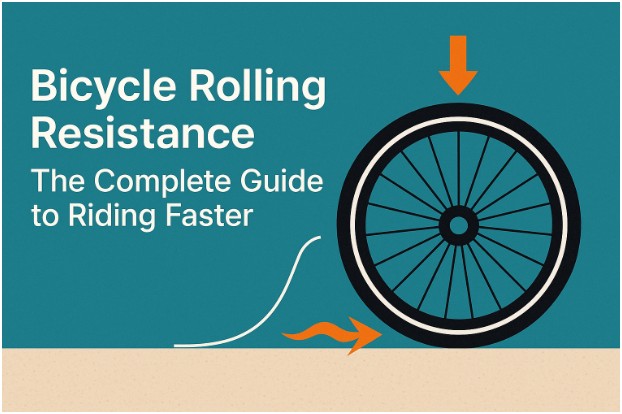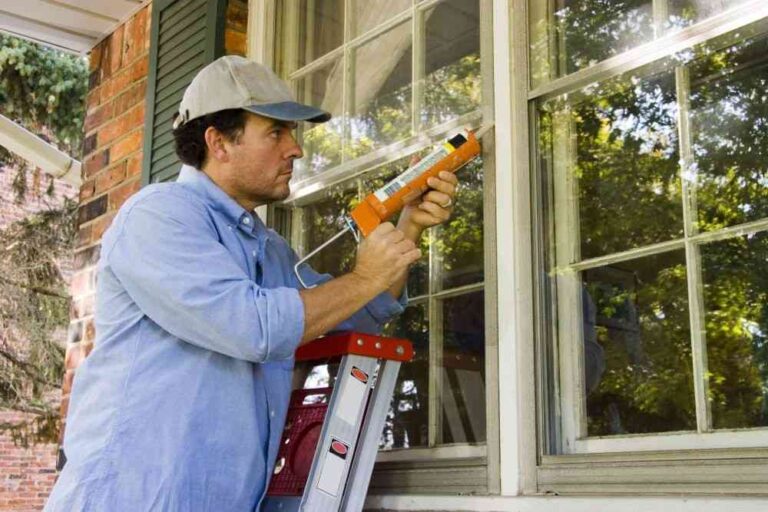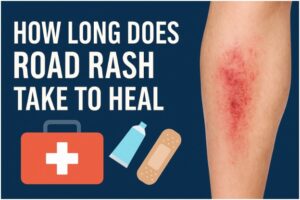When I first started road cycling, I thought the only thing that mattered was how strong my legs were. Then I learned about bicycle rolling resistance, and it completely changed how I approached my rides.
Rolling resistance quietly saps your energy every time your tires touch the ground—and lowering it can make you noticeably faster with zero extra effort.
This guide breaks down what rolling resistance is, what affects it, how to calculate it, and how to reduce it for real-world speed gains.
What Is Bicycle Rolling Resistance?
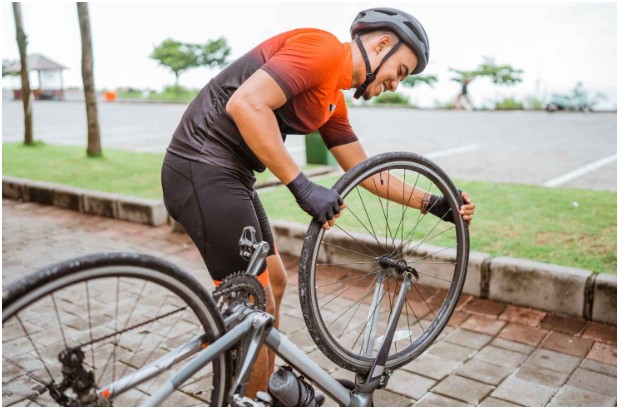
Bicycle rolling resistance is the energy lost as your tires deform while rolling, mainly because of the hysteresis (heat loss) of the rubber compound.
Each time your tire contacts the ground, it squishes and flexes. That flexing absorbs energy and creates a friction force that pushes back against your forward motion. The more your tires deform, the more energy you lose—and the slower you go.
Minimizing this resistance improves your speed, endurance, and overall riding efficiency, whether you’re racing or just cruising to work.
Factors That Affect Rolling Resistance
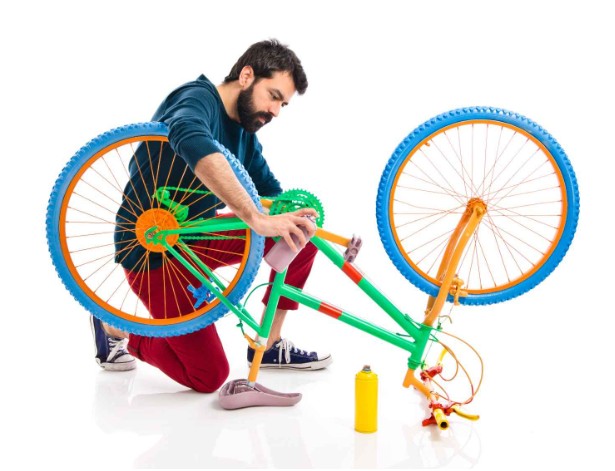
Several variables play a major role in how much rolling resistance your bike tires generate. Understanding these will help you make smarter gear and setup choices.
Tire Pressure
- Smooth surfaces: Higher pressures reduce tire deformation, creating a smaller contact patch and lowering resistance.
- Rough terrain: Slightly lower pressures let the tire conform to surface irregularities, reducing bouncing and vibration losses. This often improves grip and lowers resistance on chipseal or gravel.
Tire Type and Construction
Tread pattern: Slick or semi-slick tires have lower resistance than knobby tires, which are built for off-road grip. More aggressive tread means more energy lost through squirming and deformation.
Casing and compound: Supple casings and advanced rubber compounds (like silica blends) flex and rebound efficiently, wasting less energy as heat.
Width: Wider tires can actually roll faster than narrow ones at the same pressure because they produce a shorter, wider contact patch that deforms less. They also allow lower pressures on rough roads without a speed penalty.
Surface and Terrain
- Smooth asphalt offers the lowest rolling resistance.
- Rough roads, gravel, dirt, sand, or snow increase resistance dramatically because the tire must deform more or the surface itself absorbs energy.
Total Weight
- More mass from the rider, bike, and gear increases the normal force on the tires.
- Higher load = more deformation = higher rolling resistance.
Speed
- The power needed to overcome rolling resistance increases linearly with speed, while air resistance rises exponentially.
- Above ~20 km/h (12 mph), air drag becomes the dominant force, but rolling resistance still matters—especially on climbs or long rides.
The Formula for Rolling Resistance
Rolling resistance can be estimated using this simple equation:
Frr=Crr×WF_{rr} = C_{rr} \times W
Where:
- FrrF_{rr} is the rolling resistance force.
- CrrC_{rr} is the coefficient of rolling resistance (a dimensionless number). Typical values for bicycle tires range from 0.0025 to 0.005 on rollers.
- WW is the total normal force (weight of the bike and rider), calculated as:
W=m×gW = m \times g
where mm is total mass and gg is gravitational acceleration (9.81 m/s²).
Example:
If bike + rider = 80 kg and CrrC_{rr} = 0.004, then:
Frr=0.004×(80×9.81)≈3.14 NF_{rr} = 0.004 \times (80 \times 9.81) \approx 3.14\ \text{N}
That’s the force you must constantly overcome just to keep the tires rolling.
How to Reduce Bicycle Rolling Resistance
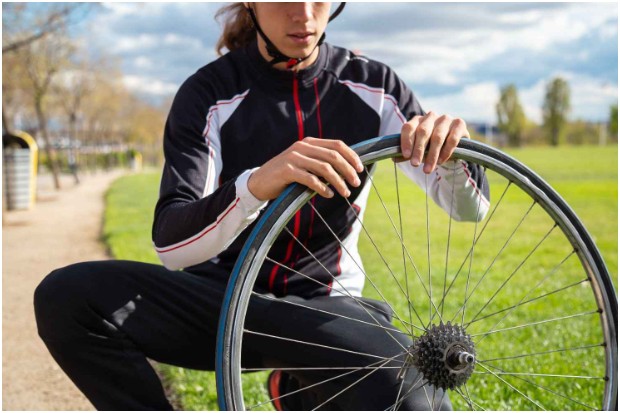
Reducing rolling resistance gives you free speed—no training required. Here’s how to do it smartly.
Choose the Right Tires
- For road cycling, pick slick or semi-slick tires with supple casings.
- For off-road, choose tires designed for your terrain—grippier tread is worth the trade-off in speed.
- Premium tires from trusted brands often use lighter casings and advanced rubber compounds to cut energy loss.
Maintain Proper Tire Pressure
- Smooth roads: Use the higher end of the manufacturer’s recommended pressure range.
- Rough surfaces: Lower the pressure slightly to absorb bumps, which reduces energy loss and improves comfort and grip.
Consider Tire Width
- Modern 25–28 mm road tires or wider gravel tires often offer lower rolling resistance and better comfort than old narrow tires.
- Wider tires spread the load across more surface area, deforming less and wasting less energy.
Reduce Overall Weight
- Cutting unnecessary gear weight and choosing lighter components reduces the load on your tires, lowering rolling resistance.
- While weight savings can be marginal, they help especially on climbs.
Even small changes here can add up to 5–15 watts saved at typical road speeds.
FAQs About Bicycle Rolling Resistance
-
How much can the right tires improve my speed?
Switching from high-resistance training tires to low-resistance performance tires can save 10–15 watts at 30 km/h. Over a multi-hour ride, that’s like free energy.
-
Are tubeless tires faster than using tubes?
Yes. Tubeless tires eliminate friction between the tube and casing, reducing rolling resistance. They also allow lower pressures without pinch flats, which can further improve real-world speed.
-
What tire pressure gives the least rolling resistance?
On smooth pavement, higher pressure reduces deformation and resistance. On rough roads, slightly lower pressure can be faster because it reduces bouncing and vibration losses.
-
Do wider tires really roll faster?
Surprisingly, yes—at the same pressure. Wider tires have a shorter, wider contact patch that deforms less. They also let you run lower pressure without adding drag, which improves comfort and control.
Rolling Easier, Riding Faster
Learning about bicycle rolling resistance completely changed my riding game. Instead of wasting energy on slow tires or wrong pressures, I now glide further with less effort.
Whether you’re chasing podiums, training for endurance, or just want a smoother daily commute, optimizing your setup for lower rolling resistance is one of the simplest—and smartest—performance upgrades you can make.

